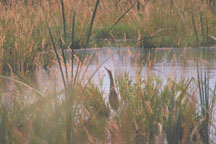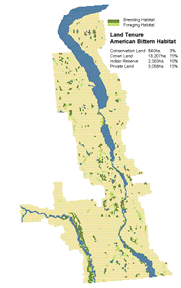|
Habitat Atlas for Wildlife at Risk
American Bittern
Botaurus lentiginosus

American
Bittern
|

- Length: 60 cm; Wingspan: 1.1 metres.
- Small, stocky brown heron with long neck and legs;
streaked brown and buff belly.
- Black stripe borders white throat and yellow bill.
Status:
British Columbia Blue List
Special Significance
American Bittern populations have declined in the South
Okanagan due to the draining and filling in of cattail
and bulrush marshes. This species would benefit greatly
from the protection of remaining wetlands and marshes.
Providing buffers along marsh edges would also assist
the protection of important habitat for this secretive
bird.
Distribution
- In British Columbia, bitterns breed north to Mackenzie in the
Interior, and in the Fraser Valley on the coast.
- Bitterns winter from southwestern British Columbia
to southern U.S. and southward.
Habitat
- Bitterns prefer marshes and wetlands with thick extensive stands
of bulrushes, cattails or sedges.
- They build well-concealed nests in thick cattail or
bulrush stands, either in a dry part of the marsh
or over shallow water; occasionally nest in fields outside the periphery
of marsh
vegetation.
- Forage mainly in aquatic habitats but also in moist
meadows or drier grasslands near wetlands.
Reproduction
- Bitterns arrive in late April or early May and migrate south in
the fall.
- Breeding season extends from April to mid-August.
- Eggs (usually 4 - 5) are laid in April through to
mid-July.
- Young bitterns likely flying by mid-August.
Food Habits
- Diet consists of insects, amphibians, crayfish, crabs, garter
snakes, dragonflies and small fish and mammals; in drier habitats
may eat
rodents, especially voles.
- Maximum known lifespan is 8 years.
Interesting Facts
- Bittern plumage matches the verticle pattern of its preferred bulrush
and cattail marsh habitat.
- This bird is most easily identified by its low, booming
call, "pump-er-lunk, pump-er-lunk," that can be heard
hundreds of meters away.
Threats
- Draining and filling of marshes and other wetlands.
- Livestock damage to wetlands and shorelines.
- Wetland deterioration due to pollution.
Management Considerations
- Protect wetlands and marshes and adjacent grassland
areas.
- Protect known nest sites from human disturbance.
- Stabilize water levels in ponds and marshes.
- Reduce and monitor use of pesticides.
- Provide buffers along stream edges to prevent
destruction due to logging, development road
construction and livestock.
|
References
1. Campbell, R.W., N.K. Dawe, I. McTaggart-Cowan, J. Cooper, G. Kaiser
and M.C. McNall. 1990. Birds of British Columbia: Volume 1. Royal
British Columbia Museum, Victoria, BC.
2. Cannings, R.A., R.J. Cannings and S.G. Cannings.
1987. Birds of the Okanagan Valley, British Columbia. Royal British
Columbia Museum, Victoria, BC. 420 pp.
3. Kaufman, K. 1996. Lives of North American birds.
Houghton Mifflin Company. Boston, New York.
|